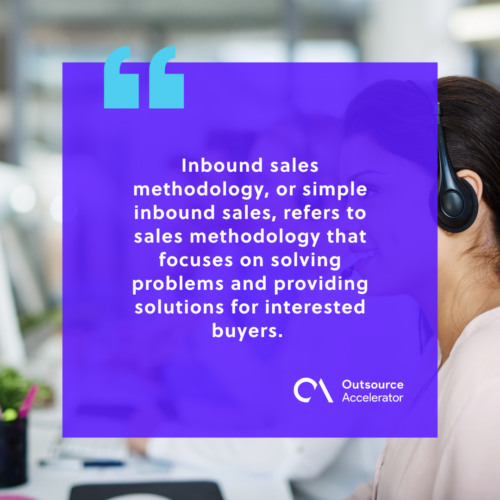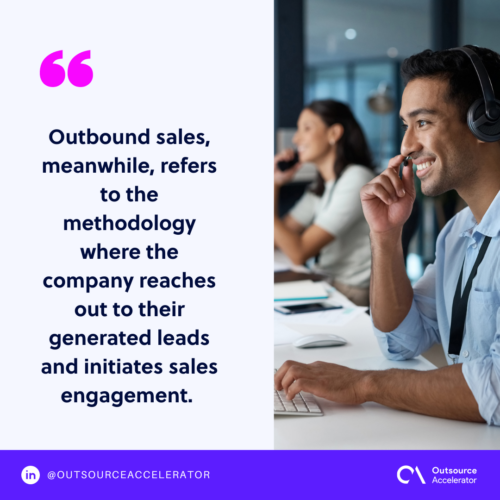The difference between inbound vs. outbound sales

Many companies are still confused about the sales methods to use for their business.
The battle between inbound and outbound sales and which would bring customers to your business better still goes on. The two methods, however, have their pros and cons within them that should be worked out.
But which sales method works better?
Let’s define inbound and outbound sales, how they work, and what a business would get if the two were combined.
What is inbound sales?
Inbound sales methodology, or simple inbound sales, refers to sales methodology that focuses on solving problems and providing solutions for interested buyers.
This aims to answer inquiries and provide more information for customers about a company’s products and services.
Customers from inbound sales are leads generated from digital marketing efforts, whether through content marketing, social media, broadcast media, or pay-per-click (PPC) advertisements.
Inbound sales follow the four-part process of identifying, connecting, exploring, and advising.

Inbound sales process
Identifying
To be successful in inbound sales, the first step is to identify a company’s prospects and the problem they’re struggling with. Companies should be proactive in thinking about these problems and coming up with solutions.
Identified individuals that the company sees fit with their offerings, meanwhile, will become leads.
Connecting
The inbound sales team should then contact these leads to determine whether to prioritize their goals or challenges. Sales representatives will help educate their leads on their problems and connect them with tailored solutions.
Connecting is important when it comes to developing trust with their prospects. Meanwhile, leads who go on with their goals will be called qualified leads.
Exploring
The inbound salesperson will then explore the qualified lead’s goals and assess whether their offers will fit their needs. They should mainly focus on the challenges they face that slow down their progress in reaching a goal.
Once they see that the lead is a good fit, they will now be considered as opportunities.
Advising
Lastly, the inbound salesperson will advise the lead on their offerings and how this will address the lead’s goals and context. This aims to show the lead how their product will address their concern and make their life easier. This is where the initial sales transaction will start.
Once the lead accepts the advice and proceeds with the transaction, they will then become a customer.
What is outbound sales?
Outbound sales, meanwhile, refers to the methodology where the company reaches out to their generated leads and initiates sales engagement. This usually involves cold calling, emailing, video calling, or texting.
Outbound sales teams maximize methods of communication when reaching out to customers. Unlike inbound sales, they also have to be determined since leads won’t come to them.
They have to be knowledgeable of the products they offer since most of their leads have little knowledge of the company and its products.
B2B and B2C outbound sales
Though almost similar in process, B2B and B2C outbound sales have distinct goals, strengths, and benefits for a company.
In business-to-business (B2B), salespeople sell to the representative of their prospective company. This usually involves a longer sales cycle, and closing a deal involves multiple touchpoints.
This is due to the prospective businesses still having to undergo several processes in approving and proceeding with the sale.
On the other hand, business-to-consumer (B2C) offers a more direct approach since they go directly to the consumers.
A salesperson or an agent usually has more leads to call than their B2B counterparts since the latter needs to be more strategic in targeting their prospects.

Comparing inbound vs. Outbound sales process
Inbound and outbound sales differ greatly in terms of various factors, such as the following:
Establishing sales relationships
When choosing between an inbound or outbound sales process, determine how you want your sales relationship established.
Inbound sales teams are responsible for answering inbound leads and customer inquiries. Their target audience is either existing customers or prospects acquired through other lead generation strategies.
Meanwhile, the outbound sales team is tasked to reach out to prospective customers. Their task includes telemarketing and lead prospecting.
Turnaround time
Turnaround times between inbound and outbound sales strategies also vary.
Naturally, inbound strategies take time to generate leads and reach a target audience. This is because marketing through website content and social media may take time and consistency to get actual traction in the market.
On the other hand, an outbound sales strategy may have a quicker turnaround time. This is because the company will reach out directly to its leads, helping them rapidly get through the entire sales process.
Lead qualification
Lastly, inbound and outbound sales may have varying qualifications for their leads.
In inbound sales, sales reps may qualify their leads first according to their level of interest in the company and their product needs.
For outbound sales, meanwhile, teams may do a follow-up to confirm whether the lead will push through with the product.
Inbound vs. Outbound sales: Which can grow your business?
A company may choose to focus on either inbound or outbound sales to its advantage. However, successful ones utilize both to maximize their growth.
Inbound sales help them attract customers, manage costs, and scale employees more effectively. Meanwhile, outbound sales can maximize generated leads, build trust, and close bigger deals.
In the end, both sales methods will work depending on the plans and strategies a company uses. These can even be improved by outsourcing them to a sales firm or a BPO company.
An outsourcing partner like 123Employee can help a business know what method they should focus on and hire experts to do the rest of the work for the company.
With this, they can maximize their growth in a cost-efficient way and even expand their market over time.







 Independent
Independent




